Continuously variable transmission
A continuously variable transmission (CVT) is an automatic transmission that can change seamlessly through a continuous range of gear ratios. This contrasts with other transmissions that provide a limited number of gear ratios in fixed steps. The flexibility of a CVT with suitable control may allow the engine to operate at a constant RPM while the vehicle moves at varying speeds.
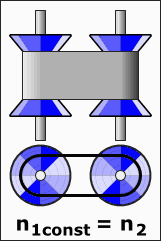
CVTs are used in automobiles, tractors, motor scooters, snowmobiles and earthmoving equipment.
The most common type of CVT uses two pulleys connected by a belt or chain, however several other designs have also been used at times.
Types
Pulley-based
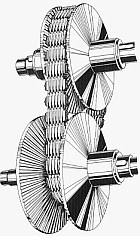
The most common type of CVT uses a V-belt which runs between two variable diameter pulleys.[1] The pulleys consist of two cone-shaped halves which move together and apart. The V-belt runs between these two halves, so the effective diameter of the pulley is dependent on the distance between the two halves of the pulley. The V-shaped cross section of the belt causes it to ride higher on one pulley and lower on the other, therefore the gear ratio is adjusted by moving the two sheaves of one pulley closer together and the two sheaves of the other pulley farther apart.[2]
As the distance between the pulleys and the length of the belt does not change, both pulleys must be adjusted (one bigger, the other smaller) simultaneously in order to maintain the proper amount of tension on the belt. Simple CVTs combining a centrifugal drive pulley with a spring loaded driven pulley often use belt tension to effect the conforming adjustments in the driven pulley. The V-belt needs to be very stiff in the pulley's axial direction in order to make only short radial movements while sliding in and out of the pulleys.
The pulley-radial thickness of the belt is a compromise between maximum gear ratio and torque. Steel reinforced v-belts are sufficient for low-mass low-torque applications like utility vehicles and snowmobiles but higher mass and torque applications such as automobiles require a chain. Each element of the chain must have conical sides that fit the pulley when the belt is running on the outermost radius. As the chain moves into the pulleys the contact area gets smaller. As the contact area is proportional to the number of elements, chain belts require many very small elements.
A belt-driven design offers approximately 88% efficiency,[3] which, while lower than that of a manual transmission, can be offset by enabling the engine to run at its most efficient RPM regardless of the vehicle's speed. When power is more important than economy, the ratio of the CVT can be changed to allow the engine to turn at the RPM at which it produces greatest power.
In a chain-based CVT a film of lubricant is applied to the pulleys. It needs to be thick enough so that the pulley and the chain never touch and it must be thin in order not to waste power when each element dives into the lubrication film. Additionally, the chain elements stabilize about 12 steel bands. Each band is thin enough so that it bends easily. If bending, it has a perfect conical surface on its side. In the stack of bands each band corresponds to a slightly different drive ratio, and thus they slide over each other and need oil between them. Also the outer bands slide through the stabilizing chain, while the center band can be used as the chain linkage.
Some CVTs transfer power to the output pulley via tension in the belt (a "pulling" force), while others use link element compression where the input pulley "pushes" the belt which in turn pushes the output pulley.[4][5][6]
Toroidal
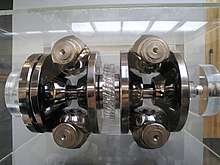
Toroidal CVTs, as used on the 1999 Nissan Cedric (Y34),[7][8] consist of a series of discs and rollers. The discs can be pictured as two almost conical parts, point to point, with the sides dished such that the two parts could fill the central hole of a torus. One disc is the input, and the other is the output. Between the discs are rollers which vary the ratio and which transfer power from one side to the other. When the roller's axis is perpendicular to the axis of the discs, the effective diameter is the same for the input discs and the output discs, resulting in a 1:1 drive ratio. For other ratios, the rollers are moved along the axis of the discs, resulting in the rollers being in contact with the discs at a point which has a larger or smaller diameter, giving a drive ratio of something other than 1:1.[9]
An advantage of a toroidal CVT is the ability to withstand higher torque loads than a pulley-based CVT.[10] In some toroidal systems, the direction of thrust can be reversed within the CVT, removing the need for an external device to provide a reverse gear.[11]
Ratcheting
A ratcheting CVT uses a series of one-way clutches or ratchets that rectify and sum only "forward" motion. The on-off characteristics of a typical ratchet means that many of these designs are not continuous in operation (i.e. technically not a CVT), however in practice there are many similarities in operation and a ratcheting CVT is able to produce a zero output speed from any given input speed (as per an Infinitely Variable Transmission). The drive ratio is adjusted by changing linkage geometry within the oscillating elements, so that the summed maximum linkage speed is adjusted, even when the average linkage speed remains constant.
Ratcheting CVTs can transfer substantial torque, because their static friction actually increases relative to torque throughput, so slippage is impossible in properly designed systems. Efficiency is generally high, because most of the dynamic friction is caused by very slight transitional clutch speed changes. The drawback to ratcheting CVTs is vibration caused by the successive transition in speed required to accelerate the element, which must supplant the previously operating and decelerating, power transmitting element.
The design principle dates back to before the 1930s, with the original design intended to convert rotary motion to oscillating motion and back to rotary motion using roller clutches.[12] This design remains in production as of 2017, for use with low speed electric motors.[13] A prototyped as a bicycle transmission was patented in 1994.[14] The operating principle for a ratcheting CVT design using a scotch yoke mechanism to convert rotary motion to oscillating motion and non-circular gears, to achieve uniform input to output ratio, was patented in 2014. [15]
Hydrostatic
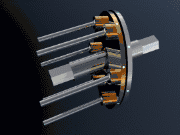
Hydrostatic CVTs use a variable displacement pump and a hydraulic motor, therefore the transmission converts hydraulic pressure to rotation of the output shaft. The advantages of hydrostatic CVTs are:
- ability to transmit more torque
- can be mounted directly to the wheel hub, allowing a more flexible suspension system and reducing drivetrain losses
- all forward and reverse speeds can be accessed using a single lever.
However, the design can be sensitive to contamination and expensive to produce. They are not suited to transmitting high torque for extended durations, since the hydraulic fluid can overheat in these circumstances.
Uses of hydrostatic CVTs include forage harvesters, combine harvesters, small wheeled/tracked/skid-steer loaders, crawler tractors, and road rollers. One agricultural example, produced by AGCO Corporation, splits power between hydrostatic and mechanical transfer to the output shaft via a planetary gear in the forward direction of travel (in reverse the power transfer is fully hydrostatic).[16]
A variant called the Integrated Hydrostatic Transaxle (IHT) uses a single housing for both hydraulic elements and gear-reducing elements, and is used in some mini-tractors and ride-on lawn mowers.
The 2008-2010 Honda DN-01 cruiser motorcycle used a hydrostatic CVT, in the form of a variable displacement axial piston pump with a variable-angle swashplate.
The Japanese Type 10 tank uses hydraulic mechanical transmission.
Cone
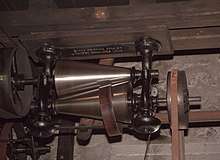
A cone CVT varies the drive ratio by moving a wheel or belt up and down the axis of conical roller(s). The simplest type of cone CVT, the single-cone version, uses a wheel that moves along the slope of the cone, creating the variation between the narrow and wide diameters of the cone.
Some designs of cone CVTs use two rollers.[17][18] The Evans Friction Cone— produced in the 1920s— uses two rollers which are oriented so that a small constant-sized gap is present between the rollers.[19] A leather strap sits in the gap between the rollers, pressed against both rollers in order to transfer motion from the input roller to the output roller. The drive ratio of the transmission is adjusted by moving this strap along the axis of the rollers.
In a CVT with oscillating cones, the torque is transmitted via friction from a variable number of cones (according to the torque to be transmitted) to a central, barrel-shaped hub. The side surface of the hub is convex with a specific radius of curvature which is smaller than the concavity radius of the cones. In this way, there will be only one (theoretical) contact point between each cone and the hub at any time.
Epicyclic
_in_planet_configuration.jpg)
In an epicyclic CVT (also called a planetary CVT), the gear ratio is shifted by tilting the axes of spheres in a continuous fashion, to provide different contact radii, which in turn drive input and output discs. The system can have multiple "planets" to transfer torque through multiple fluid patches. Production versions include the Toyota e-CVT (which debuted on the 1997 Toyota Prius)[20] and the NuVinci CVT.[21]
Other types
Friction-disk transmissions were used in several tractors and small locomotives built in the early decades of the 20th century. These transmissions consist of an output disk which could be moved across the surface of the input disk upon which it rolled. When the output disk was adjusted to a position equal to its own radius, the resulting drive ratio was 1:1. The drive ratio could be set to infinity (i.e. a stationary output disk) by moving the output disk to the centre of the input disk. The output direction could also be reversed, by moving the disk past the centre of the input disk. The transmission on early Plymouth locomotives worked this way, while on tractors using friction disks, the range of reverse speeds was typically limited.[22]
A magnetic CVT transmits torque using a non-contact magnetic coupling rather than physical contact.[23] The design uses two rings of permanent magnets with a ring of steel pole pieces between them, in order to create a planetary gearset using magnets.[24] It is claimed to produce a 3 to 5 percent reduction in fuel consumption, compared with a mechanical system.[24]
Infinitely variable transmissions
Some CVTs can also function as an infinitely variable transmission (IVT) which offer an infinite range of low gears (e.g. moving a vehicle forward at an infinitely slow speed). Some IVTs prevent back-driving (where the output shaft can freely rotate, like an automotive transmission in neutral) due to providing a high back-driving torque. Other IVT, such as ratcheting types, allow the output shaft to freely rotate. The types of CVTs which are able to function as IVTs include epicyclic, friction-disk and ratcheting CVTs.
In an epicyclic CVT, the infinitely low drive ratios are produced when the output shaft rotation speed which is equal to the difference between two other speeds within the CVT. In this situation, the CVT is functioning as a regulator of the rotation speed of any one of the three rotators of the planetary gear system. Since two of the rotators are the input and output of the regulator, the CVT can be configured to result in an output speed of zero for any given input speed. The CVT's input speed is always the same as the motor, even when the output speed is zero.
Origins
In 1879, Milton Reeves invented a CVT (then called a variable-speed transmission) for use in saw milling. In 1879 Reeves began fitting this transmission to his cars,[25] and the Reeves CVT was also used by several other manufacturers.
The 1911 Zenith Gradua 6HP motorcycle used a pulley-based Gradua CVT.[26][27] A year later, the Rudge-Whitworth Multigear was released with a similar but improved CVT. Other early cars to use a CVT were the 1913-1923 David small three-wheeled cyclecars built in Spain,[28] the 1923 Clyno built in the U.K., and the 1926 Constantinesco Saloon built in the U.K.
Applications
Automobiles
The first mass-production car to use a CVT was the 1958 DAF 600 small sedan built in the Netherlands.[29] This Variomatic transmission was used in several vehicles built by DAF and Volvo until the 1980s.[30]
The 1987 Ford Fiesta (second generation) and Fiat Uno (first generation) became the first cars to be equipped with steel-belted CVT (as opposed to the less robust rubber-belted DAF design). The Multitronic transmission was developed by Ford, Van Doorne, and Fiat, with work on the transmission starting in 1976.[31]
Also in 1987, the ECVT was introduced as an optional transmission on the Subaru Justy,[32][33] Production was limited to 500 units per month as Van Doorne's Transmissie in The Netherlands could only produce this many steel belts for them. In June, supplies increased to 3,000 per month, leading Subaru to make the CVT available in the Subaru Rex Kei car.[34] Subaru has also supplied its CVTs to other manufacturers (such as the 1992 Nissan Micra).[31]
The 1996 Honda Civic (sixth generation) introduced a pulley-based Multi Matic CVT which included a torque converter, for low-speed "creep" action).[35]
Use of CVTs then spread in the following years to models including the 1998 Nissan Cube, 1999 Rover 25 and 1999 Audi A6.[36] Marketing terms for CVTs include "Lineartronic" (Subaru), "Xtronic" (Jatco, Nissan, Renault), INVECS-III (Mitsubishi), Multitronic (Volkswagen, Audi), "Autotronic" (Mercedes-Benz) and IVT (Hyundai, Kia).
The 1999 Nissan Cedric (Y34) used a toroidal CVT— unlike the pulley-based designs used by other manufacturers— marketed as the Nissan Extroid and which incorporated a torque converter. Nissan then switched from toroidal to pulley-based CVTs in 2003.[37] The version of the CVT used with a V6 engine in the Nissan Altima is claimed to be capable of transmitting higher torque loads than other belt CVTs.[38]
The 2019 Toyota Corolla (E210) is available with a CVT assisted by a physical "launch gear" alongside the CVT pulley. Up to 40 km/h (25 mph), the transmission uses the launch gear, in order to increase acceleration and reduce the stress on the CVT. Above this speed, the transmission switches over to the CVT pulley.[39]
Several hybrid electric vehicles- such as the Toyota Prius, Nissan Altima and Ford Escape Hybrid- use Electric Variable Transmissions (EVTs) to control the contribution of power from the electric motor and the internal combustion engine. Despite the similar name, these are fundamentally different devices from CVTs (which are powered by a single source).
Racing cars
In the United States, Formula 500 open-wheeler racing cars have used CVTs since the early 1970s. CVTs were prohibited from Formula One in 1994 (along with several other electronic systems and driver aids) due to concerns over escalating research and development costs, and maintaining a specific level of driver involvement with the vehicles.[40]
Small vehicles
Many small vehicles— such as snowmobiles, golf carts and motor scooters— use CVTs, typically the rubber belt or variable pulley variety. CVTs in these vehicles often use a rubber belt design with a non-stretching fixed circumference manufactured using various highly durable and flexible materials, due to the mechanical simplicity and ease of use outweighing their comparative inefficiency. Some motor scooters include a centrifugal clutch, to assist when idling or manually reversing the scooter.[41]
The 1974 Rokon RT340 TCR Automatic off-road motorcycle was fitted with a snowmobile CVT. The first ATV equipped with a CVT was the Polaris Industries Trail Boss in 1985.
Farm and earthmoving equipment
Combine harvesters used variable belt drives as early as the 1950s. Many small tractors and self-propelled mowers for home and garden use simple rubber belt CVTs. Hydrostatic CVTs are more common on the larger units. In mowing or harvesting operations, the CVT allows the forward speed of the equipment to be adjusted independently of the engine speed; this allows the operator to slow or accelerate as needed to accommodate variations in thickness of the crop.
Small to medium-sized agricultural and earthmoving equipment often uses hydrostatic CVTs. Since the engines in these machines are typically run at constant power output (to provide hydraulic power or to power machinery), losses in mechanical efficiency are offset by enhanced operational efficiency. For example, in earthmoving equipment, the forward-reverse shuttle times are reduced. The speed and power output of the CVT is used to control the travel speed of the equipment and sometimes also to steer the equipment. In the latter case, the required speed differential to steer the equipment can be supplied by independent CVTs, allowing steering to be accomplished without several drawbacks associated with other skid steer methods (such as braking losses or loss of tractive effort).
The 1965 Wheel Horse 875 and 1075 garden tractors were the first such vehicles to be fitted with a hydrostatic CVT. The design used a variable-displacement swash-plate pump and fixed-displacement gear-type hydraulic motor combined into a single compact package. Reverse ratios were achieved by reversing the flow of the pump through over-centering of the swash plate. Acceleration was limited and smoothed through use of pressure accumulator and relief valves located between the pump and motor, to prevent the sudden changes in speed possible with a direct hydraulic coupling. Subsequent versions included fixed swash plate motors and ball pumps.
The 1996 Fendt Vario 926 was the first ever heavy-duty tractor to be equipped with a hydrostatic CVT.[42] Over 100,000 tractors have been produced with this transmission.[42]
Power generating systems
CVTs have been used in aircraft electrical power generating systems since the 1950s.
CVTs with flywheels are used as a speed governor between an engine (e.g. a wind turbine) and the electric generator. When the engine is producing sufficient power, the generator is connected directly to the CVT which serves to regulate the engine's speed. When the power output is too low, the generator is disconnected and the energy is stored in the flywheel. It is only when the speed of the flywheel is sufficient that the kinetic energy is converted into electricity, intermittently, at the speed required by the generator.
Other uses
Some drill presses and milling machines contain a simply belt-drive CVT system to control the speed of the chuck. In this system, the effective diameter of the output shaft pulleys are adjustable due to their conical shape. The pulley on the motor is usually fixed in diameter (or sometimes with discreet steps to allow a selection of speed ranges). The operator adjusts the speed of the drill by using a hand-wheel that controls the width of the gap between the pulley halves. A tensioner pulley is implemented in the belt transmission to take up or release the slack in the belt as the speed is altered.
Winches and hoists are also an application of CVTs, especially for those adapting the transmission ratio to the resistant torque.
Bicycles with CVT gearing have had limited commercial success, with one example providing a range of gearing equivalent to an eight-speed shifter.[43] The bicycle short gearing assisted when cycling uphill, however the CVT was noted to significantly increase the weight of the bicycle.[44]
See also
| Automotive transmissions |
|---|
| Manual |
| Automatic / Semi-automatic |
References
- Fischetti, Mark (January 2006). "No More Gears". Scientific American. 294 (1): 92–3. Bibcode:2006SciAm.294a..92F. doi:10.1038/scientificamerican0106-92. PMID 16468439.
- "Diagram of Pulley-based CVT's". www.howsuffworks.com. 27 April 2005. Retrieved 17 June 2011.
- "CVT Efficiency" (PDF). www.zeroshift.com. Archived from the original (PDF) on 14 July 2014. Retrieved 22 April 2014.
- Ambrósio, Jorge A. C. (5 July 2005). "Advances in Computational Multibody Systems". Springer. p. 271. Retrieved 8 July 2020.
- Pfeiffer, Friedrich (2008). Mechanical System Dynamics. Springer. p. 320. ISBN 978-3-540-79436-3. Retrieved 8 July 2020.
- "CVT Transaxle Steel Push Belt Construction". www.youtube.com. Weber State University. Retrieved 8 July 2020.
- "Nissan's Weird Double CVT Is Perfect for High-Torque Applications". www.roadandtrack.com. 5 December 2018. Retrieved 16 July 2020.
- "Tech & Trends: Nissan Producing Amazing New CVT". www.wardsauto.com. 1 December 1999. Retrieved 16 July 2020.
- "How CVTs Work - Toroidal CVTs". www.howstuffworks.com. 27 April 2005. Retrieved 16 July 2020.
- "Extroid CVTs - For Application to Rear-Wheel-Drive Cars Powered by Large Engine" (PDF). www.nissan-global.com. Retrieved 16 July 2020.
- "Developments in Full-Toroidal Traction Drive Infinitely & Continuously Variable Transmissions (CTI Innovative Automotive Transmissions Conference and Exhibition)" (PDF). Torotrak. August 2007. Archived from the original (PDF) on 17 September 2012.
- Franklin, D. (1930). Ingenious mechanisms for designers and inventors ... (1st ed.). Industrial Press. pp. 343–345. ISBN 0-8311-1084-8.
- "drives". www.zero-max.com. Archived from the original on 1 March 2009. Retrieved 19 September 2009.
- "US patent US5516132A: Variable-speed transmission". 22 July 1994. Retrieved 17 July 2020.
- "US patent US9970520B2: Continuous variable transmission with uniform input-to-output ratio that is non-dependent on friction". 18 March 2014. Retrieved 17 July 2020.
- "AGCO's Continuously Variable Transmission (CVT) Explained". Retrieved 26 October 2012.
- "CVT Explained". www.youtube.com. Retrieved 27 August 2011.
- "CVT transmission". www.youtube.com. Retrieved 27 August 2011.
- "Evans Friction Cone Co. advertisement". Machinery Magazine. 19 January 1922. Retrieved 18 July 2020.
- "Pros and Cons of a Toyota CVT Transmission". www.galetoyota.com. 27 April 2016. Retrieved 18 July 2020.
- "Continuously variable planetary transmission". www.oemoffhighway.com. 21 February 2011. Retrieved 18 July 2020.
- Engineers, Society of Automotive (1918). "Tractor Friction Transmissions". The Journal of the Society of Automotive Engineers: 440.
- "Magnets offer advantages as an alternative to mechanical gears". www.engineerlive.com. 7 February 2012. Retrieved 7 February 2012.
- "Magnetic Continuously Variable Transmission". www.magneticsmag.com. 4 November 2013. Retrieved 16 July 2020.
- "A tale of two brothers". www.gasenginemagazine.com. Retrieved 19 July 2020.
- "Property of Pete Gagan, 1914 Zenith-JAP 8hp 'Gradua' Twin Frame no. 4499 Engine no. 46612". www.bonhams.com. Retrieved 19 July 2020.
- "How it works: CVT". www.classicsworld.co.uk. 4 January 2019. Retrieved 19 July 2020.
- "DAVID HISTORIA". www.autopasion18.com.
- "When Did Cars Start Using the CVT Automatic?". www.autotrader.com. Retrieved 10 July 2020.
- Hilton Holloway, Martin Buckley (2002). 20th Century Cars. Carlton. ISBN 978-1-84222-835-7.
- Poulton, M.L. (1997). Fuel Efficient Car Technology. Computational Mechanics Publications. p. 69. ISBN 978-1-85312-447-1.
- "Fuji Heavy Industries to increase production of ECVT systems". Nihon Keizai Shimbun. Tokyo: 12. 13 June 1987.
- "What Is a Continuously Variable Transmission (CVT)?". www.edmunds.com. 13 February 2001. Retrieved 10 July 2020.
- "Fuji Heavy Industries to increase production of ECVT systems". Nihon Keizai Shimbun: 12. 13 June 1987.
- "Honda Worldwide - Technology Picture Book - CVT". www.honda.com. Retrieved 19 October 2015.
- "Audi multitronic transmission". www.audiworld.com. Retrieved 10 July 2020.
- "Nissan Technological Development Activities Overview: Xtronic Cvt". www.nissan-global.com. Archived from the original on 5 September 2012. Retrieved 19 September 2009.
- "CVT". Jatco. Archived from the original on 4 December 2010. Cite journal requires
|journal=(help) - 2019 Toyota Corolla Hatch: Top 5 Things You Need to Know!. www.youtube.com. 15 April 2018. Retrieved 29 December 2019.
2019 Toyota Corolla Hatch: Top 5 Things You Need to Know!
- Keith Collantine (3 May 2007). "Banned! Continuously Variable Transmission". www.F1fanatic.co.uk. Retrieved 17 June 2011.
- "use of clutch with CVT". www.scootnfast.com. Retrieved 6 January 2012.
- "Fendt History". www.fendt.com. Retrieved 26 October 2012.
- "Here's Proof That Commuter Bikes Don't Have to Suck". www.wired.com. Retrieved 8 July 2020.
- "How A Bike With Infinite Gears Changed The Way I Commute". www.gizmodo.com.au. 5 February 2017. Retrieved 12 July 2020.